
ORIGINAL ARTICLE
Extract of Vermicompost Liplant an Alternative for the Development of Conservation Agriculture
Extracto de vermicompost Liplant una alternativa para el desarrollo de la agricultura de conservación
Dr.C. Mayra Arteaga BarruetaI*, Dr.C. Nelson Garcés Pérez II, M.Sc. José Antonio Pino Roque III, Ing. Liliam Otaño CoronaI, Lic. Helen Veubides AmadorI
I Universidad Agraria de la Habana, Facultad Agronomía, Departamento de Química, San José de las Lajas, Mayabeque, Cuba.
II Universidad de La Habana, Vedado, Plaza, La Habana, Cuba.
III Universidad Agraria de la Habana, Facultad Ciencias Técnicas, Departamento de Matemática, San José de las Lajas, Mayabeque, Cuba.
ABSTRACT
To look for ecological alternatives, obtained from residuals of the own agroecosystems, has become a challenge in the current investigations to revert the problematic low productivity of the cultivations, like black bean production, that do not satisfy the population's high demands. The present work had as objective to evaluate the effects of the application of a vermicompost extract (LIPLANT) on the agricultural productivity in cultivations of economic interest, when being applied in combination with other bioproducts, as well as in the preservation of the properties of a soil Leached Red Ferrallitic (FRL) conserved under production conditions of a small farm in town. The results obtained demonstrated that with this product applied to plants of bean, alone or added with the technology of conservation developed by the producer according to the existent conditions in the property, the productivity of the cultivation can be increased and a more rational use of the vermicompost material can also be done. It determines that its application is viable, with economic and ecological impact. With the application of LIPLANT a better positive productive answer to the improvement of the soil preserved FRL was achieved.
Keywords: ecological alternative, agroecosystem, agricultural productivity.
RESUMEN
Buscar alternativas ecológicas obtenidas a partir de residuos de los propios agroecosistemas se ha convertido en un reto en las investigaciones actuales para revertir las problemática de la baja productividad de los cultivos, como es el caso del frijol negro, que no llegan a satisfacer las altas demandas de la población. El presente trabajo tuvo como objetivo: Evaluar los efectos de la aplicación de un extracto de vermicompost (LIPLANT) sobre la productividad agrícola en un cultivos de interés económico, al aplicarse combinado con otros bioproductos, así como en la preservación de las propiedades de un suelo Ferralítico Rojo Lixiviados (FRL) conservado en las condiciones de producción de una pequeña finca de la localidad. Los resultados obtenidos demostraron que con este producto aplicado a las plantas de frijol, por si sólo o adicionado con la tecnología de conservación desarrollada por el productor de acuerdo a las condiciones existentes en la finca, se puede incrementar la productividad del cultivo y hacer un uso más racional del material vermicompostado, lo que determina que su aplicación sea más viable, con un impacto no sólo económico sino también ecológico. Con la aplicación del LIPLANT se logró una mejor repuesta productiva positiva al mejoramiento del suelo FRL conservado.
Palabras clave: alternativas ecológica, agroecosistema, productividad agrícola.
INTRODUCTION
Meeting the high food demand of the population is one of the main challenges of Cuba's economic policy, which has among its bases the sustainable development of agriculture. To this end, the global economic crisis that leads to the scarcity of inputs (Lehmann y Kleber, 2015), the impact on the productive capacity of soils such the Red Ferrallitic leached in more than 50% (Hernández et al., 2015), among other factors that have a limited effect on crop production (ONEI, 2015) have to be faced. Under these conditions, the different forms of production in Cuba have now increased, mainly small farms, plots and organoponics in urban localities. In general, under these conditions, they cannot be self-sufficient with the agroecosystems' own resources for the preparation of composted or vermicomposting organic matter. They are dependent on the external obtaining of large volumes of these materials (4 t ha- 1), which cannot be supplied externally, by objective and subjective factors, to maintain the annual productivity of crops in a sustainable manner. The application of vermicompost biostimulant has demonstrated its great benefits in increasing the biological and agricultural production of crops with favorable ecological effects (du Jardin, 2015; Piccolo, 2016).
Obtaining vermicompost extracts such as LIPLANT, whose production process is low cost and from natural products, concentrates substances with high biological activity proving to be a solution to these problems. They are biostimulant of plant growth when they are applied in low dilutions on the plants, consequently reducing the amount of vermicompost material used to obtain a positive response in them and during their systematic application, they can contribute to the conservation of the soil where they are used (Arteaga et al., 2007; Arteaga, 2014). The beneficial effect of humic acids extracted from vermicomposting has been verified by different authors(Calderín et al., 2012, 2014a,b; Berbara y García, 2014). In the literature there are no studies over time that involve the application of Liplant extract combined with other biofertilizers natural products (Ecomic and Biofert) with plant growth stimulating effects. It is not yet known the contribution of this combination of products to the improvement of conserved soils, with which a positive response to their improvement has not been achieved (Hernández et al., 2011). In turn, integrate the application of the product to the conditions existing on the farm at the time of the study. The objective of the present work was to evaluate the effects of the application of a vermicomposting extract (LIPLANT) combined with other biofertilizers on the increase of black bean production, as well as, the conservation of the properties of Red Ferrallitic soils in the production conditions of a small farm in San José de las Lajas town.
METHODS
The experiment was carried out in three crop cycles (CC) of black bean, variety ICA Pijao, line 32 improved, from the end of October to the beginning of March, under conditions of production of a farm belonging to CCS "Manuel Fajardo¨, located in San Jose de las Lajas Municipality, Mayabeque Province. It consists of a Ferrallitic Red Leached soil (Hernández et al., 2011).
For their study, soil samples were randomly collected (40 subsamples) on the diagonal of the study area (54 m2) after being prepared and homogenized to obtain standard samples. They were analyzed before the first sowing of the first crop cycle (CC1) and after completion of the last crop (CC3). The indicators evaluated were soil organic matter (MO%, Tyurin Colorimetry Method λ = 559 nm, ISO 10390: (1999), pH (Potentiometric, ISO 10390: 1999), cation exchange capacity (CIC, Shatcshabel method NC 65: 2000), relation Ca2+/Mg2+ (Complexity, phosphorus content (P, Oniani method NC 52: 1999) and potassium (K, Flame photometry), apparent bulk density (Rings method), electrical conductivity (EC, Conductimetry NC 112: 2001).
Soil evaluations showed characteristics of a conserved red Ferrallitic soil (Table 1), according to the degradation indicators reported for this type of soil (Hernández et al., 2011).

It is a soil with an appropriate fertility to ensure the good development of the crop in it (Agüero et al., 2013) and with a conservation state that will allow the fulfillment of the objectives proposed in the experiment.
These results correspond to the conservation management carried out by the farmer for more than five years: (I) application of residues of the previous crop or of the natural vegetation developed in the stage of non-soil cultivation (fallow) through the minimum tillage of the soil; (II) addition of composted or vermicomposting organic matter at the bottom of the furrow 2-4 T.ha-1; (III) use of natural products in different variants combined or not, according to the existence in the market when sowing.
For the development of the experiment, at the time of direct seeding, Ecomic ® from National Institute of Agricultural Sciences and Biofer RF® from Institute of Soil were combined to cover bean seeds and 2 T.ha- 1 of vermicompost were added, as control variant (TP). As a second treatment to be evaluated, the combination of this technology was used with the application of Liplant diluted 1:30 v: v. Foliar Liplant spraying was applied with 16 L knapsack sprayer as drip irrigation, in two moments in the early stages of the crop development (1st application in a total volume of 50 L.ha-1 with the third trifoliate leaf and 2nd of 150 L.ha-1 15 days after the first application). It will be designated as TP + L1 / 30 treatment.
Growth index of plant height and leaves and number of flowers were among the morphophysiological indicators evaluated 15 days after each leaf application (15, 30, 45 days after sowing) to 15 plants randomly selected for each replicate for a total of 60 plants per treatment. Other indicators were the biochemical-physiological indicators (leaf area duration DAF, growth rate TRC: (ln msf-ln msi) / (tf- ti), net assimilation rate, TAN: [(msf-msi) / (AFf-AFi )] [(lnAFf-lnAFi) / (Tf-Ti)] up to 30 days after application of the products (Azcón & Talón, 2013).
The productive indicators were number of pods per plant, seed per pod and mass of 100 seeds. The yield R (T.ha-1) was obtained from the total production by treatment area which was estimated extrapolating to one hectare. For economic analysis of production, the economic indicators were evaluated in national currency, according to FAO methodology (2015) for each treatment: value of production ($ / ha) obtained from the price of 100kg of black bean up to 9 460 pesos, referred at that time by the Collection Center of San Jose de las Lajas (MINAG, 2008), and expenses incurred as reported by the producers considering: soil preparation, seed price, cultural attention (irrigation, earthing up, weeding), application of products according to the variants developed in the farm. The benefits ($.ha-1) and the cost / invested peso ratio, reported for each treatment in the three crop cycles evaluated, were calculated.
The climatic variables measured during the development of the experiment: rainfall (mm), temperature (0C) and relative humidity (%), were taken from the Territorial Weather Station of Tapaste, San José de las Lajas, Mayabeque. They are reflected in Figure 1.
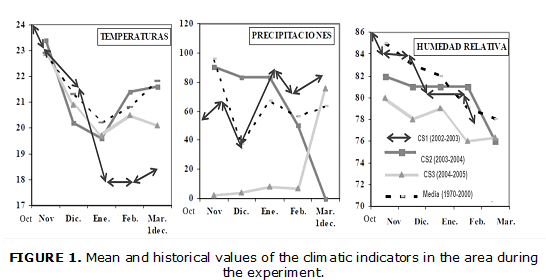
These climatic variables remained within the characteristic range for this area during the last 35 years, except the precipitations that were kept scarce, reason why it was necessary to irrigate.
According to the crop requirements, temperatures and humidity were presented as tolerant to the crop, according to the technical instructions (Agüero et al., 2013).
The cultivation work carried out for all treatments was recommended by the technical standards of the crop: manual earthing up, clearing, with irrigation of 7-10 days if it does not rain, especially in the stage of flowering and beginning of fruiting.
For the statistical processing of the information, the statistical program Statgraphics Plus version 5.1 (Statistical Graphics Crop, 2000) was used. A randomized block experimental design with four replicates per treatment, was used and the parametric analysis of variance analysis of double classification was applied for the study of the biological, productive and soil properties indicators to the treatments, with stages of evaluation and with cultivation cycle. Tukey's multiple comparison test (Tukey, 1949) was also used to detect differences with a significance of 5%. In the analysis of the variables counting number of leaves, flowers, pods and seeds per plant the transformation √n was applied.
RESULTS AND DISCUSSION
Among the three crop cycles, the results of the indicators evaluated, in general, were reproducible with respect to the previous one. The growth rates of the plants treated with Liplant showed a stimulation with respect to those of the control.
Figure 2 and 3 show the mean values of the growth rates of plant height and leaf development, respectively. In the first one, in the dynamics evaluated, a stimulation with the application of Liplant superior to the control between 17-25% at 15 dds, 36,5-51,9% at 30dds and at 45dds is doubled.
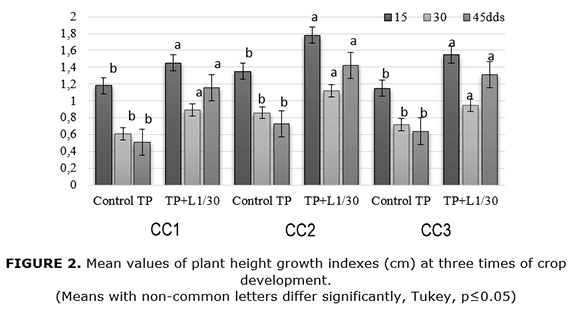
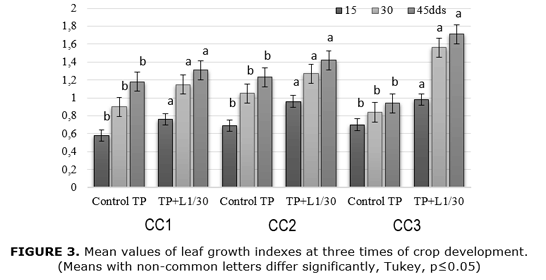
In foliar development at 15dds, an increasing of 11-26% is obtained reaching up to 46% at 45 dds. Similarly, in the number of flowers, the increasing is 21% higher until the values are doubled to 45 dds with respect to the control in the three cycles evaluated, (Figure 4). This can be justified with the calculation of the duration of the leaf area significantly favored (p≤0.05) for the treatments that added Liplant (Table 2). It suggests a greater persistence of photosynthetically active leaf surface during crop growth with respect to control.
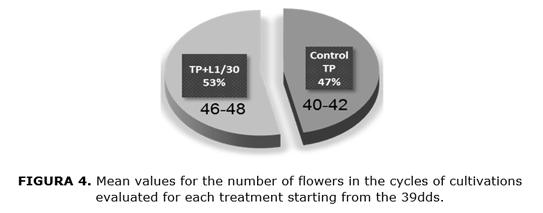
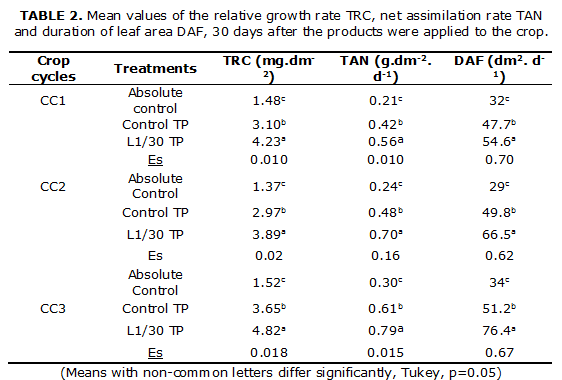
This effect was reported in the cultivation of black beans with the application of mulch and foliate Biostan (Hernández et al., 2008). It corresponds in another culture of type C3, like tomato with the application of vermicompost extracts (Arteaga et al., 2006; Terry et al., 2010). As well as the effect of humic substances obtained from vermicompost (Calderín et al., 2012, 2014b; Canellas et al., 2015).
These results correspond to the relative growth and net assimilation (TAN) rates calculated (Table 2). Increases achieved for the treatments that added Liplant in each crop cycle corroborate how efficient becomes the process of biomass production (Azcón & Talón, 2013).
With the TAN, the increase in dry mass per unit of leaf surface, per unit of time is defined, which indicates the balance between the photosynthetic process and respiration (Haghighi et al., 2012). This effect is of great importance in this C3 crop that is not very efficient when presenting losses by photorespiration (Calderín et al., 2016).
In relation to this, these plants should be favored in the production of photoassimilates, as a result of a more efficient photosynthetic process, because these are the organs in charge directly of that process in the plants, which can have repercussion in the greater formation of biomass, part of which would be directed towards the formation of leaves and structures (Nardi et al., 2016; Susic, 2016).
The comparison of these results against an absolute control that did not receive any added alternative fertilization suggests and ratifies the aforementioned, because with the application of these bioproducts, the physiological and biochemical state of the plants is improved, which guarantees a greater benefit with the application of Liplant in concentration L1 / 30.
These effects may have an impact on the increased photosynthetic capacity of the plant, which corresponds to the results obtained and the application of the extract of vermicompost Liplant in tomato (Arteaga, 2014).
The results are related to those obtained in the productive indicators of the crop (Figure 5), which in the variant that received Liplant was significantly different (p≤0.05) than the TP control for the three crop cycles evaluated . For the number of pods per plant and the mass of 100 seeds in the variant of Liplant insertion to the production technology (L1 / 30 + TP) for the three cycles, increases are obtained with respect to the control between a 9,2- 15.2% and 14.3-25.8%, respectively.
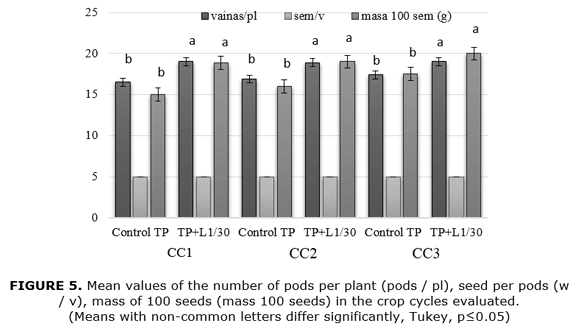
These effects, coupled with the growth rates analyzed, suggest a more efficient mobilization of the nutrients in the treatments with Liplant towards the grain, which can affect the greater mass of the seeds and therefore to increase the productive yield in a 26 , 2-51.8% with respect to the culture that did not received Liplant (Table 3). They correspond to the application of Liplant dilutions to these concentrations in this crop and in tomato under conditions of production in Padron Farms, Mayabeque Province with compacted Red Ferrallitic soils (Arteaga, 2014) and the references obtained with the application of humic acids from vermicompost where their effects on the metabolic efficiency of the treated plants and hormonal like effects assigned to these substances were manifested (Berbara y García, 2014; Savy et al., 2016).
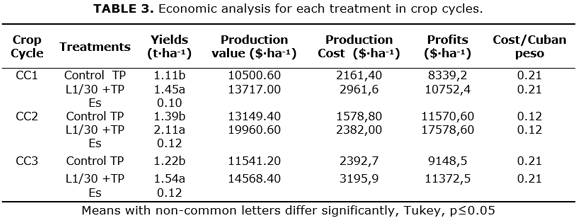
The economic evaluation of the results obtained from the productive indicators evaluated for each treatment and cultivation cycle are reflected in Table 3. The efficiency of the application of Liplant with the variant used is shown, given by the cost / price relation obtained, which, in spite of Liplant introduction, does not vary from the control due to the increase in the production value with the higher yields, which brings higher profits in 51.9% (CC1), 28.94% (CC2) and 24.3% (CC3). In the last two cycles smaller than the first, costs increased with the greater application of irrigation due to the scarcity of rains that occurred in those stages.
In general, the economic result obtained justifies the economic feasibility of the introduction of Liplant like a bioactive product as a viable alternative to incorporate the technology of sustainable black bean production practices under the conditions of production of a small farm, either alone or combined with other bioproducts such as Ecomic and Rhizobium.
This behavior suggests the positive Liplant interaction and compatibility with mycorrhiza, rhizobium and applied composite organic matter can be positive in the proper development of the plants with the combination of these ecological products. It was possible to appreciate the biostimulating effect of Liplant in this culture being advantageous its application in the moments studied. These reports lead to the need of finding in future research more adequate and efficient relationship in the applied amounts of these bioproducts, which individually have demonstrated their benefits and possibilities to achieve a possible potentiation of their effects according to the results.
After the three crop cycles evaluated (Table 4), the introduction of Liplant to the production technology of the farm had a positive response in the improvement of soil properties such as organic matter, cation content of the soil and of phosphorus, as well as the capacity of cationic exchange, being conserved the rest of the evaluated properties.

There is a tendency to increase soil carbon sequestration by approximately 3% in the three years of study. The results suggest that with the stimulation achieved in the metabolic activity observed in plants with the introduction of Liplant to the production technology in their individual action (Arteaga et al., 2007), or in conjunction with the products used, according to previous analyses could make an efficient and more rational use of the nutrients of the soil and contribute in some measure to the conservation of the soil during its use.
The results coincide with the reports by Arteaga (2014), when introducing the systematic application of vermicompost Liplant extract to the dilutions used, in long-term studies with the cultivation of Amalia tomato in conservation technologies, corresponding in the literature established when applying liquid humus to leaves of vegetables and grains (Quaik et al., 2012; Zandonadi et al., 2014).
All the above allows to evaluate under the conditions of production studied, the possibility of Liplant use, as a biostimulant of black bean plant growth (ICA Pijao) and in its interaction with other bioproducts in their indirect effects on the soil-plant system which allows it, in its use over time, to contribute to the conservation of these soils. It has not been mentioned in the literature with a positive response to the improvement of their properties with the use of bioproducts as those used in the experiment. A more efficient agroproductive response to the improvement of Red Ferrallitic soils was observed in the properties related to their fertility (Garcés et al., 2009; Hernández et al., 2011).
CONCLUSIONS
The insertion of leaf applications of vermicompost extract Liplant to black bean plants in the initial stages of their growth, into the productive system of a farm with conservation management caused significant and reproducible increases in the biological and agricultural productivity of the crop, achieving economic gains, ecological factors that justify it as a viable and efficient perspective within the framework of sustainable agriculture when inserted into conservation technologies applied in the long term.
AGÜERO, F.Y.; SANTIESTEBAN, S.R.; TAMAYO, G.E.; BATISTA, S.D.: “Comportamiento de 16 variedades de frijol (Phaseolus vulgaris L.) en suelo Sialítico de la provincia Granma”, Granma Ciencia, 17(2), 2013, ISSN: 1027-975X, Disponible en: http://www.grciencia.granma.inf.cu/2013_17_n2_a4.html, [Consulta: 14 de septiembre de 2016].
ARTEAGA, M.: Liplant: una alternativa para la producción ecológica del tomate, Universidad Agraria de La Habana, Tesis de Doctorado, Mayabeque, Cuba, 100 p., 2014.
ARTEAGA, M.; GARCÉS, N.; GURIDI, F.; PINO, J.; CARO, I.; BERNARDO, O.; CALZADILLA, J.; MESA, S.; LÓPEZ, A.; RUISÁNCHEZ, Y.; MENÉNDEZ, J.; CARTAZA, O.: “Respuestas del tomate Amalia a las aplicaciones de humus líquido en condiciones de producción”, Cultivos tropicales, 32(3): 7–12, 2006, ISSN: 1819-4087.
ARTEAGA, M.; GARCÉS, N.; NOVO, R.; GURIDI, F.; PINO, J.A.; ACOSTA, M.; PASOS, M.; BESÚ, D.: “Influencia de la aplicación foliar del bioestimulante Liplant sobre algunos indicadores biológicos del suelo”, Revista de Protección Vegetal, 22(2): 110-117, agosto de 2007, ISSN: 1010-2752.
AZCÓN, J.; TALÓN, M.: Fundamentos de fisiología vegetal, Ed. McGraw-Hill, España, 651 p., 2013, ISBN: 978-84-481-9293-8.
BERBARA, R.L.L.; GARCÍA, A.C.: “Humic Substances and Plant Defense Metabolism”, [en línea], En: Physiological Mechanisms and Adaptation Strategies in Plants Under Changing Environment, Ed. Springer, New York, NY, pp. 297-319, 2014, DOI: 10.1007/978-1-4614-8591-9_11, ISBN: 978-1-4614-8590-2, Disponible en: https://link.springer.com/chapter/10.1007/978-1-4614-8591-9_11, [Consulta: 14 de septiembre de 2017].
CALDERÍN, G.A.; AZEVEDO, S.L.; GURIDI, I.F.; RUMJANEK, V.M.; CASTRO, R.N.; DOS SANTOS, F.S.; DE SOUZA, L.G.A.; BERBARA, R.L.L.: “Potentialities of vermicompost humic acids to alleviate water stress in rice plants (Oryza sativa L.)”, Journal of Geochemical Exploration, 136: 48-54, enero de 2014a, ISSN: 0375-6742, DOI: 10.1016/j.gexplo.2013.10.005.
CALDERÍN, G.A.; AZEVEDO, S.L.; GURIDI, I.F.; SPERANDIO, M.V.L.; CASTRO, R.N.; BERBARA, R.L.L.: “Vermicompost humic acids as an ecological pathway to protect rice plant against oxidative stress”, Ecological Engineering, 47: 203-208, octubre de 2012, ISSN: 0925-8574, DOI: 10.1016/j.ecoleng.2012.06.011.
CALDERÍN, G.A.; DE SOUZA, L.G.A.; PEREIRA, M.G.; CASTRO, R.N.; GARCÍA-MINA, J.M.; ZONTA, E.; LISBOA, F.J.G.; BERBARA, R.L.L.: “Structure-Property-Function Relationship in Humic Substances to Explain the Biological Activity in Plants”, Scientific Reports, 6(1), agosto de 2016, ISSN: 2045-2322, DOI: 10.1038/srep20798, Disponible en: http://www.nature.com/articles/srep20798, [Consulta: 14 de septiembre de 2017].
CALDERÍN, G.A.; GURIDI, I.F.; BERBARA, R.L.L.: “Effects of Humic Materials on Plant Metabolism and Agricultural Productivity”, [en línea], En: Emerging Technologies and Management of Crop Stress Tolerance, Ed. Elsevier, pp. 449-466, 2014b, DOI: 10.1016/B978-0-12-800876-8.00018-7, ISBN: 978-0-12-800876-8, Disponible en: http://linkinghub.elsevier.com/retrieve/pii/B9780128008768000187, [Consulta: 14 de septiembre de 2017].
CANELLAS, L.P.; OLIVARES, F.L.; AGUIAR, N.O.; JONES, D.L.; NEBBIOSO, A.; MAZZEI, P.; PICCOLO, A.: “Humic and fulvic acids as biostimulants in horticulture”, Scientia Horticulturae, 196: 15-27, noviembre de 2015, ISSN: 0304-4238, DOI: 10.1016/j.scienta.2015.09.013.
DU JARDIN, P.: “Plant biostimulants: Definition, concept, main categories and regulation”, Scientia Horticulturae, 196: 3-14, noviembre de 2015, ISSN: 0304-4238, DOI: 10.1016/j.scienta.2015.09.021.
FAO: “Producción mundial de frijol”, [en línea], En: FAOSTAT, FAO Statistics Division, 2015, Disponible en: http://faostat3.fao.org/home/E, [Consulta: 20 de junio de 2016].
GARCÉS, N.; HERNÁNDEZ, A.; CARO, I.; ARTEAGA, M.: “The humus of Cuban soils in preserved tropical ecosystems and the energy”, Terra, 27(2): 85-96, 2009, ISSN: 0187-5779.
HAGHIGHI, M.; KAFI, M.; FANG, P.: “Photosynthetic Activity and N Metabolism of Lettuce as Affected by Humic Acid”, International Journal of Vegetable Science, 18(2): 182-189, 1 de abril de 2012, ISSN: 1931-5260, DOI: 10.1080/19315260.2011.605826.
HERNÁNDEZ, del V.G.; LEÓN, N.P.; CRUZ, la P.O.; INDRANI, R.Y.: “Influencia del mulch en los índices de crecimiento del frijol variedad «Bat-304»”, Revista Ciencias Técnicas Agropecuarias, 17(4): 46-49, 2008, DOI: 1010-2760.
HERNÁNDEZ, A.; VARGAS, D.; BORGES, Y.; RÍOS, H.; MORALES, M.; FUNES, F.: “Reservas de carbono orgánico en suelos Ferralíticos Rojos”, En: Ríos, H.; Vargas, D. y Funes, F. (eds.), Innovación agroecológica, adaptación y mitigación del cambio climático, Ed. Ediciones INCA, 1.a ed., Mayabeque, Cuba, pp. 45-54, 2011, ISBN: 978-959-7023-52-4.
HERNÁNDEZ, J.A.; PÉREZ, J.J.M.; BOSCH, I.D.; CASTRO, S.N.: Clasificación de los suelos de Cuba 2015, Ed. Ediciones INCA, Mayabeque, Cuba, 93 p., 2015, ISBN: 978-959-7023-77-7.
ISO (INTERNATIONAL ORGANIZATION FOR STANDARDIZATION): Calidad del suelo. Análisis Químico. Determinación del % de Materia Orgánica Calidad del suelo. Determinación del pH, [en línea], no. ISO 10390, p. 7, 1999, Disponible en: https://www.iso.org/standard/40879.html, [Consulta: 14 de septiembre de 2016].
LEHMANN, J.; KLEBER, M.: “The contentious nature of soil organic matter”, Nature, 528(7580): 60-68, 3 de diciembre de 2015, ISSN: 0028-0836, DOI: 10.1038/nature16069.
MINAG (MINISTERIO DE LA AGRICULTURA): Precios de los productos agropecuarios en el año, Inst. MINAG, Mayabeque, Cuba, 89 p., Empresa de Acopio, San José de las Lajas, 2008.
NARDI, S.; PIZZEGHELLO, D.; SCHIAVON, M.; ERTANI, A.: “Plant biostimulants: physiological responses induced by protein hydrolyzed-based products and humic substances in plant metabolism”, Scientia Agricola, 73(1): 18-23, febrero de 2016, ISSN: 0103-9016, DOI: 10.1590/0103-9016-2015-0006.
OFICINA NACIONAL DE NORMALIZACIÓN: Determinación de formas móviles del fósforo y potasio, no. NC 52, La Habana, Cuba, 1999.
OFICINA NACIONAL DE NORMALIZACIÓN: Calidad del suelo. Determinación de la capacidad de intercambio catiónico y de cationes intercambiables del suelo, no. NC 65, La Habana, Cuba, p. 8, 2000.
OFICINA NACIONAL DE NORMALIZACIÓN: Calidad del suelo. Determinación de la conductividad eléctrica y sales solubles totales en suelos afectados por salinidad. Rel. suelo-agua 1, no. NC 112, La Habana, Cuba, p. 5, 2001.
ONEI (OFICINA NACIONAL DE ESTADÍSTICA E INFORMACIÓN): “Producción de hortalizas”, [en línea], En: Panorama Territorial. Cuba 2014, Ed. ONEI, La Habana, Cuba, p. 1, 2015, Disponible en: http://www.one.cu/publicaciones/08informacion/panoramaterritorial2014/23%20Produccion%20hortalizas.pdf, [Consulta: 15 de febrero de 2016].
PICCOLO, A.: “In memoriam Prof. F.J. Stevenson and the Question of humic substances in soil”, Chemical and Biological Technologies in Agriculture, 3(1), diciembre de 2016, ISSN: 2196-5641, DOI: 10.1186/s40538-016-0076-2, Disponible en: http://chembioagro.springeropen.com/articles/10.1186/s40538-016-0076-2, [Consulta: 14 de septiembre de 2017].
QUAIK, S.; EMBRANDIRI, A.; RUPANI, P.F.; IBRAHIM, M.H.: “Potential of vermicomposting leachate as organic foliar fertilizer and nutrient solution in hydroponic culture: a review”, [en línea], En: II International Conference on Environment and BioScience, Ed. IACSIT Press, vol. 44, Singapore, pp. 43–47, 2012, Disponible en: http://www.academia.edu/download/31331913/ICEBS2012-F00019.pdf, [Consulta: 14 de septiembre de 2017].
SAVY, D.; COZZOLINO, V.; NEBBIOSO, A.; DROSOS, M.; NUZZO, A.; MAZZEI, P.; PICCOLO, A.: “Humic-like bioactivity on emergence and early growth of maize (Zea mays L.) of water-soluble lignins isolated from biomass for energy”, Plant and Soil, 402(1-2): 221-233, mayo de 2016, ISSN: 0032-079X, 1573-5036, DOI: 10.1007/s11104-015-2780-2.
STATISTICAL GRAPHICS CROP: STATGRAPHICS® Plus, [en línea], (Versión 5.1), [Windows], ser. Profesional, 2000, Disponible en: http://www.statgraphics.com/statgraphics/statgraphics.nsf/pd/pdpricing.
SUSIC, M.: “Replenishing Humic Acids in Agricultural Soils”, Agronomy, 6(4): 45, 28 de septiembre de 2016, ISSN: 2073-4395, DOI: 10.3390/agronomy6040045.
TERRY, A.E.; RUIZ, P.J.; DIAZ, de A.M.M.: “Respuesta del cultivo del tomate (Solanum lycopersicon L) a la aplicación foliar de un bioestimulante derivado del Vermicompost”, Temas de Ciencia y Tecnología, 14(41): 27–32, 2010, ISSN: 2007-0977.
TUKEY, J.W.: “Comparing Individual Means in the Analysis of Variance”, Biometrics, 5(2): 99-114, 1949, ISSN: 0006-341X, DOI: 10.2307/3001913.
ZANDONADI, D.B.; SANTOS, M.P.; MEDICI, L.O.; SILVA, J.: “Ação da matéria orgânica e suas frações sobre a fisiologia de hortaliças”, Horticultura Brasileira, 32(1): 14–20, 2014, ISSN: 1806-9991, 0102-0536.
Received: 24/02/2017
Approved: 11/06/2018
*Mayra Arteaga Barrueta, Prof. Titular. Universidad Agraria de la Habana, Facultad Agronomía, Departamento de Química, San José de las Lajas, Mayabeque, Cuba. Correo electrónico: mayra@unah.edu.cu
The authors of this work declare no conflicts of interest.
This article is under license Attribution-NonCommercial 4.0 International (CC BY-NC 4.0)
The mention of commercial equipment marks, instruments or specific materials obeys identification purposes, there is not any promotional commitment related to them, neither for the authors nor for the editor.